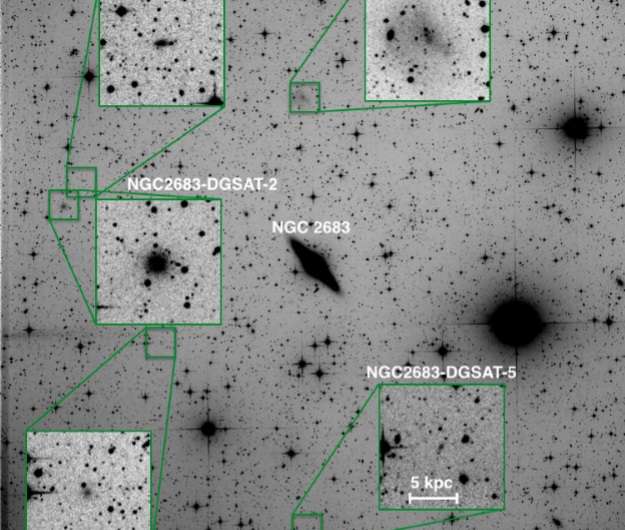November 18, 2015 report
Astronomers discover low surface brightness galaxies with amateur telescopes

(Phys.org)—An international team of astronomers led by Behnam Javanmardi of the University of Bonn in Germany has recently discovered 11 low surface brightness (LSB) systems located around nearby spiral galaxies. The researchers used small amateur telescopes to scan the sky around large galaxies and successfully obtained the images of their dim companions. A paper reporting the findings appeared last week on the ArXiv pre-print server.
The research is a part of the Dwarf Galaxy Survey with Amateur Telescopes (DGSAT) project. Its main goal is to complete the census of very faint dwarf satellites around spiral galaxies. Prior to the latest results, the project proved its efficiency by discovering tidal stellar streams, also around several nearby spiral galaxies.
By publishing the latest findings, Javanmardi and his colleagues have demonstrated that a search for LSB objects can be successfully performed with a telescope of small diameter, from 0.1 to 1 meter, having a wide field of view. The DGSAT observations were conducted with a network of privately owned robotic observatories equipped with modest-sized telescopes located in Europe, the United States, Australia and Chile.
"We developed a semi-automatic pipeline to calibrate the luminance images taken by amateur telescopes, search for dwarf galaxy candidates and extract their observed parameters. By exploring the fields of six nearby massive galaxies NGC 2683, NGC 3628, NGC 4594 (M104), NGC 4631, NGC 5457 (M101), and NGC7814, we discovered eleven so far unknown LSB galaxies in our images," the paper says.
For instance, the team pointed a 0.4-meter Newton telescope at the NGC 2683. The observations, conducted from February to March this year at the ROSA Observatory in France, allowed the researchers to spot new faint LSBs around NGC 2683. However, the largest number of new LSBs was detected in the field of the NGC 5457 galaxy. This galaxy was also observed by the same telescope at the ROSA Observatory, but in 2014.
LSBs are diffuse galaxies with a surface brightness at least one magnitude lower than the ambient night sky. Most LSBs are dwarf galaxies consisting of up to several billion stars. Dwarf satellite galaxies are the most common type of galaxies in the universe and are crucial for astronomers in testing different models of galaxy formation and evolution.
The newly discovered LSBs have similar properties to the known dwarf galaxies of the Local Group containing our home Milky Way galaxy. Nevertheless, the research shows that further observations are required to be one hundred percent sure that the discovered objects are really dwarf satellites of their nearby galaxies.
"All of the detected objects have very low surface brightness and cannot be detected in the available images from large scale surveys like the Sloan Digital Sky Survey or PanSTARRs. This also makes it very difficult to undertake follow-up observations to obtain their radial velocities and to confirm their association with the spiral galaxies even for 8-meter class telescopes," the researchers write in the paper.
They concluded that the major benefit of this study is showing the potential of amateur telescopes in discovering more dwarf galaxies. More findings could help test models of galaxy formation and evolution outside the Local Group.
More information: DGSAT: Dwarf Galaxy Survey with Amateur Telescopes I. Discovery of low surface brightness systems around nearby spiral galaxies, arXiv:1511.04446 [astro-ph.GA] arxiv.org/abs/1511.04446
Journal information: arXiv
© 2015 Phys.org




















